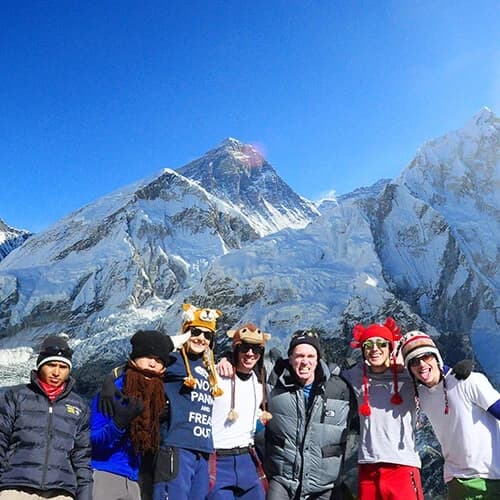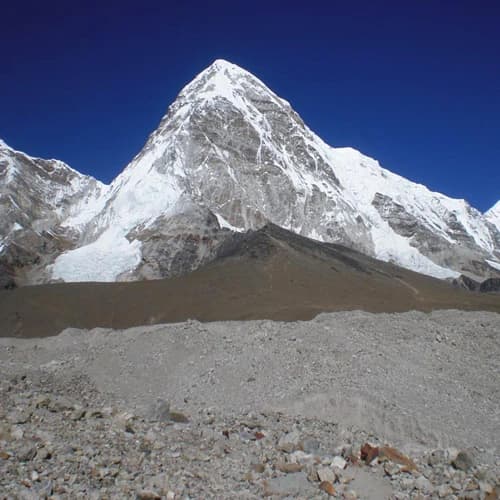1. Altitude sickness is no joke.
Acute Mountain Sickness (AMS), commonly known as altitude sickness, is a common term among high-altitude trekkers and mountaineers. When you're ascending from a lower altitude to a higher one, your body takes time to adjust naturally to the decreasing oxygen level. If you ascend too fast, your body is unable to cope with the rapid decrease in oxygen, resulting in altitude sickness.
Altitude sickness can affect anyone traveling above 3000 meters, regardless of how fit or unfit you are. Everest Base Camp lies at an elevation of 5364 meters, so there are high chances of catching AMS even before you reach the base camp. Watch out for symptoms like headache, shortness of breath even while resting, dizziness, fatigue, and loss of appetite. If the symptoms persist, stay at the same altitude for a couple of days or head down if they worsen.
If left unattended, AMS may even take lives. So, take it seriously and follow the below few points to avoid it altogether.
2. Acclimatization is the key.
Skipping acclimatization is a recipe for disaster. There's a reason why most EBC trekking itineraries include 1-2 acclimatization days. These rest days are not only important but necessary. Enough acclimatization lets your body adapt to the changing altitude properly. It also gives your body a break from all the stress caused by continuous walking.
Select an itinerary with rest days at Namche Bazaar and Dingboche for the most effective acclimatization. Choosing a suitable itinerary solves most of the concerns associated with altitude sickness.
3. Don't rush. Go slow.
Ever heard the story of the rabbit and the tortoise? The moral of the story "Slow and steady wins the race" applies even while trekking to the Everest Base Camp. Just because you're physically fit and can easily hike for a long time doesn't mean you should walk double the distance in one day. The more time you take, the easier for your body to adapt to the declining oxygen level in the air. So, take frequent breaks, admire the view, interact with fellow trekkers, and go slow. You're not running a marathon. You're on vacation, after all. Enjoy!
4. Hydration is a mantra.
3 liters of water a day keeps altitude sickness away. It is natural not to want to drink a lot of water while hiking in the cold Himalayas. But drinking at least 3 liters of water does well for your already stressed body due to lesser oxygen high up in the mountains.
Fill up your hydration bladder with enough water and sip it frequently as you hike. If drinking cold water is a problem, fill up your thermos flask with hot water from tea houses on the way. Drinking ginger tea helps too. Stay away from dehydrating agents like alcohol strictly on your way up. You can treat yourself to a drink in Namche on your way back.
5. Take your preparation seriously.
No excuses here. Go hit the gym, run, or climb the stairs instead of taking elevators and escalators. Do whatever works best for you but train your cardio-vascular system well. If you're not in good physical shape, it will be much more difficult to walk on the rough Himalayan terrain for days. Start your training at least a month before you begin the Everest Base Camp Trek.
If possible, go for easier high-altitude treks before. Annapurna Base Camp is a perfect trek to train your body to high altitudes. In 1 week, the ABC hike takes you as high as 4130 meters above sea level, which is a quick and effective high-altitude exercise.
6. Choose the right trekking company.
Booking the trek with an established trekking company makes your journey much smoother than trekking solo or hiring a private guide or a potter. Registered trekking company may be a little expensive compared to other options, but it is also the most reliable and secure. In addition to providing a qualified guide and potters and managing food and accommodation during the trek, the company you book the trek with takes care of everything from arranging permits to booking Lukla flights and helping you with helicopter rescues if necessary.
Outfitter Nepal has been arranging trekking trips all over Nepal for over a decade and stands among the top trekking companies in Nepal today. We hire local guides and potters to promote regional employment, and our trekkers have always left us with smiles and thank yous. Remember the name "Outfitter Nepal Treks and Expedition" if you're booking the EBC trek in the near future.
7. Get travel insurance.
Travel insurance is a must when you book your trip with a prestigious trekking company because they know the risks involved. There's no guarantee of anything once you're in the wild. With unpredictable weather conditions in the Himalayas, you may meet with a natural calamity or health emergency without any warning. In such unfortunate cases, having travel insurance is a relief. Make sure to get insurance with a company that covers everything from theft to hospital bills to emergency helicopter rescues.
8. Carry a first-aid kit.
A first-aid kit is a traveler's best friend, especially in the remote locations of the Everest region with inadequate healthcare facilities. Prepare a kit, especially for the EBC trek, with medicines to help with altitude sickness, water purification tablets, band-aids for blisters and cuts, pills for headaches and diarrhea, your regular medication, and so on. It would help if you were self-reliant in the mountains, as there's no well-equipped hospital on the trail.
9. Avoid infections and injuries.
Prevention is always better than cure. Be careful while walking so you don't injure yourself. Try to drink warm water as much as possible to prevent yourself from catching a cold. Beware of your allergies and eat accordingly. Always purify water before drinking unless it is boiled. Bring a pillowcase with you, so you don't get any eye, ear, or skin infections. The lodge owners can only wash the sheets occasionally due to water scarcity and cold weather. Bring your own towel and toiletries for hygiene reasons.
10. Break in your hiking boots beforehand.
The worst thing you want for yourself to happen while hiking is to get a blister. Even a small blister can prevent you from trekking forward. So make sure your hiking boots are well-adjusted to your feet before you put them in your backpack. If this is your first time hiking and you've bought a new pair of trekking boots, go for a walk around your town a few times before beginning your journey to the Everest Base Camp.
11. Come with extra days in hand.
To get to the starting point of the EBC trek, you need to get on a domestic flight to Lukla. Lukla airport, as you must know, is one of the most dangerous airports in the world. It requires the sky to be clear to land a plane on the short and inclined runway of Lukla airport. So, on days with low visibility, your flight is highly likely delayed or even postponed to the next day. Hence, it is safe to have a few extra days in hand, so you don't miss your expensive international flight back home.
12. Prepare for the flight diversion to Ramechhap.
The flights to Lukla usually take off from Kathmandu airport, and the return flights from Lukla also land in Kathmandu on most days. However, due to air traffic during peak trekking seasons (mid-spring and mid-autumn), the operation of all flights to and from Lukla shifts to Ramechhap Airport instead of Kathmandu. Ramechhap Airport lies in the Manthali municipality of Ramechhap district, which is 125km away from Kathmandu and takes about 5 hours to reach via curvy hillside roads. So plan accordingly, as this may add a day or 2 to your itinerary.
13. Buy trekking gear in Kathmandu.
You'd actually be surprised by the number of trekking equipment shops in Thamel alone. Due to the high market competition, you'll get a good deal on most trekking equipment that would cost you 10 times more back home. The quality might not be the finest, but it will serve you well in the Himalayas.
14. Pack light but carry the essentials.
The less is more when it comes to packing for any trekking trip. The weight limit of your luggage for the Lukla flight is anyway 10 kg with 5 kg carry-on baggage. The potter will also carry a maximum of 10-12 kg from each trekker. While watching the weight of your backpack, don't miss any essentials. If you pack wisely, everything you need will fit in 10 kg of luggage.
Here's a list of some essential trekking equipment that will help you pack effectively.
- Hiking boots
- Sandals/Crocs/Shoes
- Few sets of undergarments
- Good quality down jacket and pants
- Fleece jacket
- Thermal wear
- T-shirts and pants
- Warm woolen clothes for the night
- Trekking pole
- One set of gloves
- Woolen hat
- Sunhat
- Sunglasses
- Sunscreen
- Water bottle with purifying tablets
- Toiletries
- A medium-sized towel
- Wet-wipes
- Energy bars
- Basic medications
- Raingear
15. Invest in a good water filtration bottle.
Buying plastic-bottled water isn't reasonable due to the increasing plastic waste on the trail. There's less chance of getting it, anyway. Even if you find it, it will be very costly. So, the safest option is to bring a water bottle with an in-built filtration system so you can fill the bottle with water from tea houses or natural water sources along the way. Don't risk getting sick by drinking unfiltered water. You can also carry some water-purifying tablets as an alternative.
16. Exchange or withdraw cash in Kathmandu.
Always carry Nepalese rupees while trekking in Nepal. If you're traveling with cash, Kathmandu is the best place to exchange currencies. There are some money exchangers in Namche Bazaar, but the exchange rate is far better in Kathmandu. If you're using your VISA card to withdraw money, get enough cash from ATMs in Kathmandu before you fly to Lukla. You'll find a few ATMs in Namche, but they are mostly out of service.
17. Buy snacks in Kathmandu.
The higher you go, the more expensive it gets. This rule applies to almost every item in the EBC trail. The shopkeepers can't be blamed for the hiked price as things have to be airlifted and carried on the back of animals and potters to get there. So, it's better to stuff your bag with all your favorite snacks from Kathmandu itself. You'll easily find munches like Snickers, Oreos, Pringles, etc., in Kathmandu. Carrying some energy bars is also a good idea.
18. Be comfortable with basic accommodation.
You won't have to question the quality of hotels in Kathmandu as you can find cheap hotels with basic lodging to 5-star hotels, as per your budget. However, once you're on the trail, you don't get to complain about the accommodation and food.
Although the modern town of Namche Bazaar has decent options, the rest of the trail offers mountain lodges or tea houses with 2-5 individual beds in a room, depending on the size of the room. You will have to share your room with fellow trekkers in peak season. Most restrooms in these tea houses have Asian squat-style toilets with manual flushing (pouring water from a bucket). The washrooms are also available on sharing basis. So, prepare yourself for the adventure.
19. Forget showers; use wet wipes.
It is nearly impossible to take showers in the cold Everest region. The water collected in tanks freezes at night as the temperature goes below zero, even during warm months. Hot showers are difficult to get and cost you tons. So, get a few packets of wet wipes and clean your body with them. Also, add a deodorant to your packing list, as you'll sweat a lot while hiking during the day.
20. Carry a book or playing cards.
Due to a lack of energy and connectivity, the only entertainment source is a book or hanging out with other trekkers and locals by playing cards, singing songs, or sharing travel stories. So, pack your favorite book. Bring a note and a pen to scribble down your thoughts if you're among the creative ones.
Bonus Tip: Keep your devices close to your body as batteries drain faster in the cold.
21. Hike to Kala Patthar for an excellent Everest view.
You might find it strange, but you can't really see the summit of Mt. Everest from the base Camp. So, in order to have a better view of Mount Everest, don't forget to hike to Kala Patthar (5564 m). You can wake up early in Gorekshep and ascend to Kala Patthar for the majestic Himalayan sunrise. The golden hue of the morning sun striking against the snow-capped Everest and surrounding mountains give a heaven-like feeling. You can see the full face of Mt. Everest clearly from here.
22. Be respectful of local culture.
When you're in Rome, act like Romans. And, when you're in the Himalayas, respect the Sherpas. The Sherpa people are the local residents of the Everest region and most of the Himalayas. These are among the first people to climb Mt. Everest and spend a difficult life as guides and potters for trekkers and mountaineers in the region. They are the descendants of Tibetan Buddhists and have preserved their unique culture and tradition to this day. So, be a good guest by respecting their customs.
23. Enjoy!
Last but not least, remember to have fun. Going on an adventure doesn't mean you have to go into survival mode and only expect hardships. With proper planning and careful execution, you can enjoy the journey without worry. If you're traveling with friends or family, make a lifetime of memories with your loved ones. If you're trekking alone, make new friends, learn about new cultures, and take photos of yourself and the mountains. It is an opportunity of a lifetime, and only the fortunate ones get to embrace Mt. Everest up close. Be present, be humble, and enjoy to the fullest!
There you go! Those are all the 23 things you need to remember before setting out for the journey to the Everest Base Camp. We hope to have helped you plan your next adventure to Everest efficiently. Have a fantastic trip!
If you have further queries, feel free to reach out to us. Our trekking experts at Outfitter Nepal are available at all times to assist you. We would be thrilled to host you for your dream trek to the Everest Base Camp.
Suggested Some Trips




